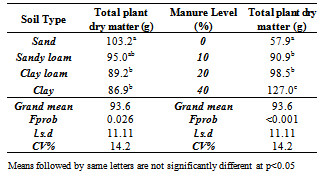-
Paper Information
- Next Paper
- Previous Paper
- Paper Submission
-
Journal Information
- About This Journal
- Editorial Board
- Current Issue
- Archive
- Author Guidelines
- Contact Us
International Journal of Agriculture and Forestry
p-ISSN: 2165-882X e-ISSN: 2165-8846
2013; 3(6): 226-230
doi:10.5923/j.ijaf.20130306.04
Effects of Soil Type and Manure Level on the Establishment and Growth of Moringa oleifera
Innocent Pahla1, Fanuel Tagwira2, Simbarashe Muzemu1, James Chitamba3
1Department of Horticulture, Faculty of Natural Resources Management and Agriculture, Midlands State University, P. Bag 9055, Gweru, Zimbabwe
2Africa University, Faculty of Agriculture and Natural Resources, P. O. Box 1320, Mutare, Zimbabwe
3Department of Agronomy, Faculty of Natural Resources Management and Agriculture, Midlands State University, P. Bag 9055, Gweru, Zimbabwe
Correspondence to: James Chitamba, Department of Agronomy, Faculty of Natural Resources Management and Agriculture, Midlands State University, P. Bag 9055, Gweru, Zimbabwe.
| Email: |  |
Copyright © 2012 Scientific & Academic Publishing. All Rights Reserved.
Moringa oleifera is considered one of the most useful trees being promoted across the world for its nutritional value. However, the production requirements of this crop are seldom known. The study was conducted to investigate the effects of soil type and cattle manure on initial establishment and growth of M. oleifera. Greenhouse experiments were conducted at Africa University, Zimbabwe in a 4×4 factorial treatment structure laid in a randomized complete block design replicated 3 times. Sandy, sandy loam, clay loam and clay soils were used while cattle manure was applied to all the soils at levels of 0, 10, 20 and 40% on mass to mass basis. Results showed that, plant height, number of branches, basal stem diameter, root, shoot and total dry biomass significantly increased (p<0.05) with an increase in the amount of cattle manure applied. An increase of 173% in M. oleifera height was recorded where 40% manure was applied. Clay loam soils significantly increased (p<0.05) M. oleifera growth rate. The study showed that application of cattle manure in acidic granitic sandy soils enhances the production of M. oleifera. A combination of clay loam and 40% manure was concluded as the best for M. oleifera establishment and growth.
Keywords: Moringa Oleifera, Soil Type, Cattle Manure, Growth, Establishment
Cite this paper: Innocent Pahla, Fanuel Tagwira, Simbarashe Muzemu, James Chitamba, Effects of Soil Type and Manure Level on the Establishment and Growth of Moringa oleifera, International Journal of Agriculture and Forestry, Vol. 3 No. 6, 2013, pp. 226-230. doi: 10.5923/j.ijaf.20130306.04.
Article Outline
1. Introduction
- Poverty in Africa has led to poor food production coupled with poor nutrition. Countries in the Sub-Saharan Africa are confronted with significant reduction in per capita cereal production and it is estimated that by 2020, cereal imports will rise to more than 30 million metric tons[1]. There is need to improve nutrition in Sub-Saharan Africa, including Zimbabwe, through the use of cheap alternative food sources. Moringa oleifera leaves are highly nutritious; one serving of the plant contains 125% calcium, 61% magnesium, 41% potassium, 71% iron, 272% Vitamin A and 22% Vitamin C daily value whilst the pods and seeds contain 5-10% crude protein and high quality oil that does not easily turn rancid[2]. M. oleifera has more beta carotene, protein, vitamin, calcium, potassium and iron than carrots, peas, oranges, milk, bananas and spinach respectively[3]. The seeds of the plant were shown to have between 17-19% oil[4].The nutritional value of M. oleifera has aroused the interests of countries and organization working among poor communities in Africa to introduce the tree. However, during establishment, M. oleifera seedlings have shown symptoms of stunted growth and yellowing of leaves, resulting in death or reduced growth. This has been attributed to low initial soil nutrition and water logging in some cases[5]. There is therefore need to use locally available soil fertility amendment resources such as cattle manure to improve its establishment and growth in resource constrained communal farmers of Zimbabwe.Cattle manure is a potential source of nutrients and also a potential benefit to soil amelioration especially for communal farmers who cannot afford fertilizers. However, getting the maximum value out of the manure requires applying it at proper rates and frequency in conjunction to a particular soil. In Zimbabwe, there are no standard recorded recommended practices for M. oleifera production. Knowledge on optimum manure requirements would significantly assist in scaling up M. oleifera production as an edible vegetable. Previous work mainly focused on M. oleifera nutritional values and its uses whilst research on establishment and growth has not received much attention despite the growing realization that M. oleifera production can be adversely affected by nutrient status of soil or media.Considering the nutritive value of M. oleifera as well as the availability of cattle manure in the country, the present study was carried out with the objective of determining the effect of soil type and level of cattle manure application on the initial establishment and growth of M. oleifera.
2. Materials and Methods
- The experiment was conducted in a greenhouse at Africa University during the 2009/2010 cropping season. The university is located at an altitude of 1063 m above sea level and on 32°36′ E and 18°53′ S. The area falls in Natural Region 1 of Zimbabwe's Agro-ecological Zones, receiving > 1000 mm rainfall per year and low mean temperature of < 15°C.The experiment was a 4×4 factorial treatment structure laid in a randomized complete block design with 3 replications, giving a total of 48 experimental units. Four soil types (sandy, sandy loam, clay loam and clay) and four well decomposed cattle manure levels (0%, 10%, 20%, 40%) were used.Organic matter content, soil pH, soil texture, inherent N, P, K for the four soil types and nutrient quality for manure were evaluated prior to seedling establishment. The results of the prior analysis of manure and soil are shown in Table 1 and Table 2 respectively. Using the Zimbabwe soil classification system, sandy soils were classified mainly as fersiallitic, 5G soils[6]. Black clays were classified as fersiallitic 3G soils whilst red sandy clay loamy was classified as orthoferallitic 7E soils[7]. Sandy loam soils were classified as paraferallitic 6G soils.
|
3. Results
- There was no interaction effect (p>0.05) between manure and soil type on root and shoot dry matter of M. oleifera. Soil type had no significant influence (p>0.05) on shoot and root dry matter whilst cattle manure level had significant influence (p<0.05) on accumulation of shoot and root dry matter (Figure 1). An increase in manure application level proportionally had a positive shoot dry matter increment as evidenced by 10, 20 and 40% versus 76.6, 83.5 and 130.8% respectively.
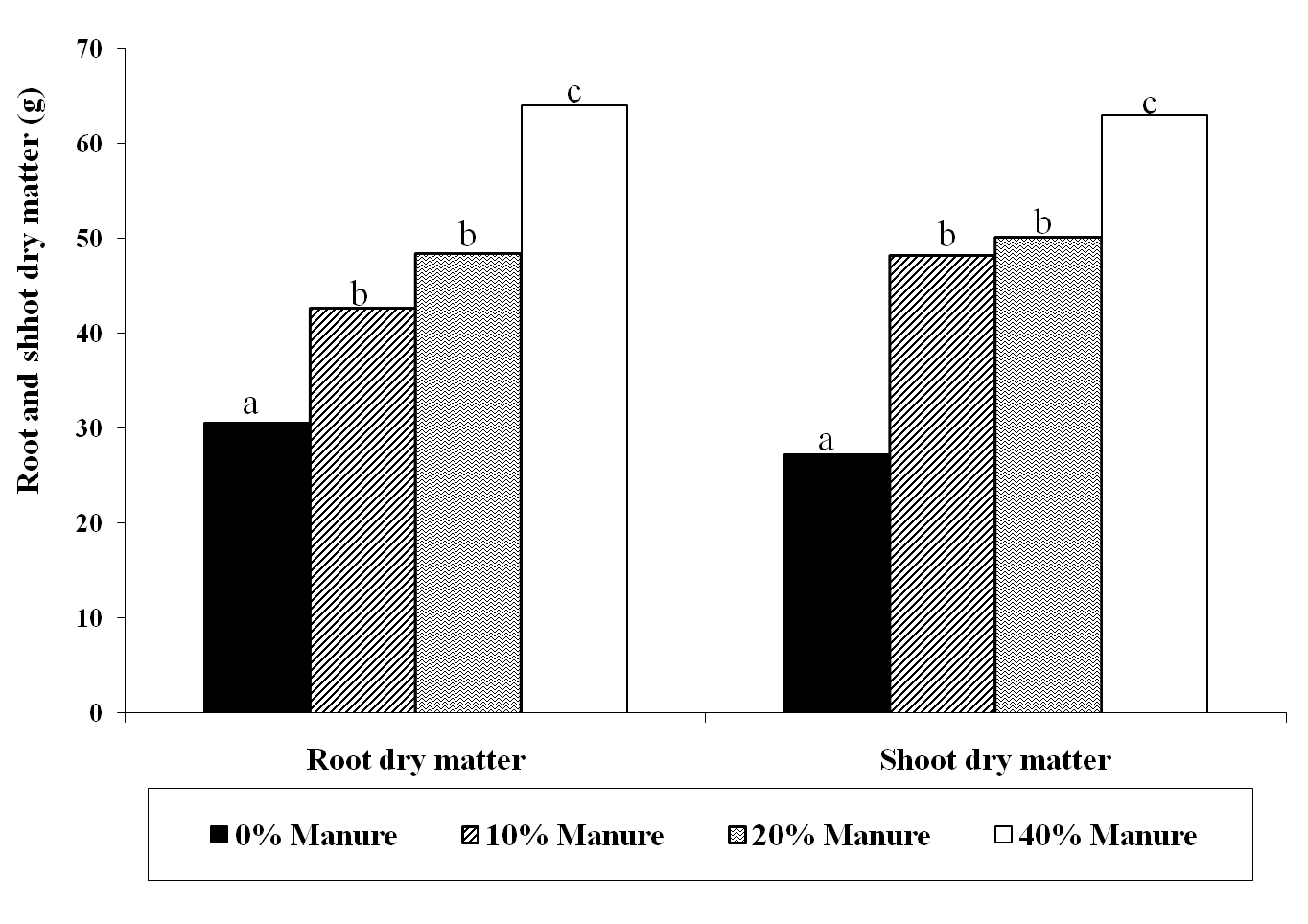 | Figure 1. Effect of manure level on shoot & root dry matter of M. oleifera |
|
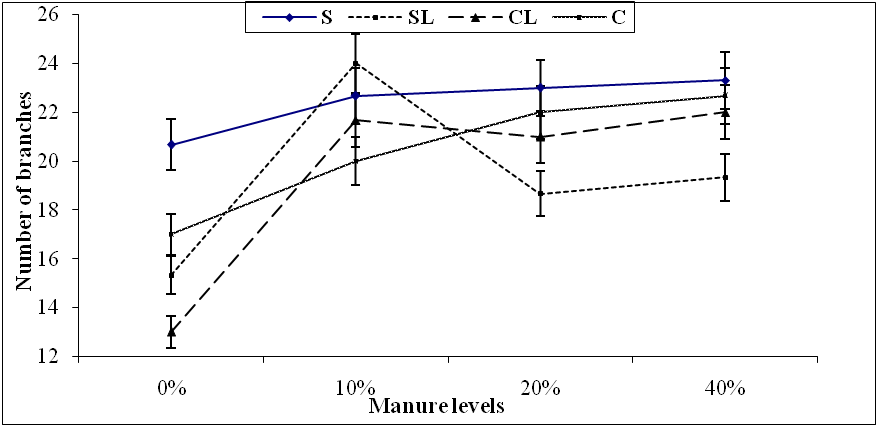 | Figure 2. Effect of soil type and manure level on branch number of M. oleifera |
|
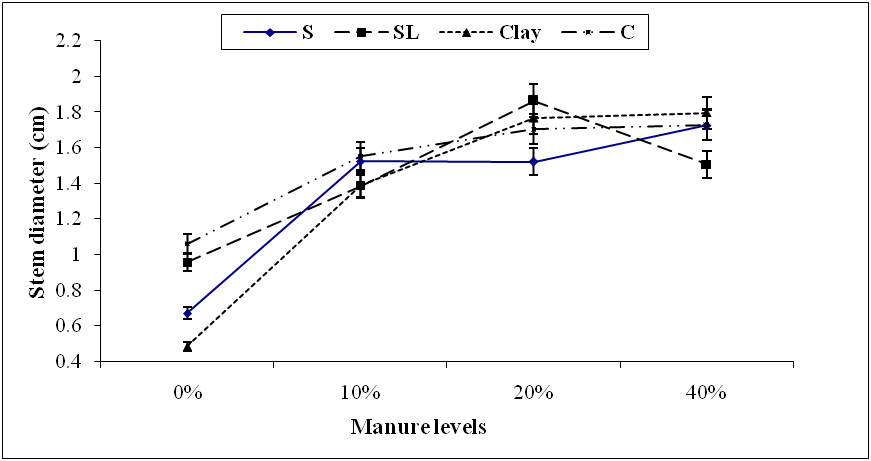 | Figure 3. Effect of soil type and manure level on basal stem diameter of M. oleifera |
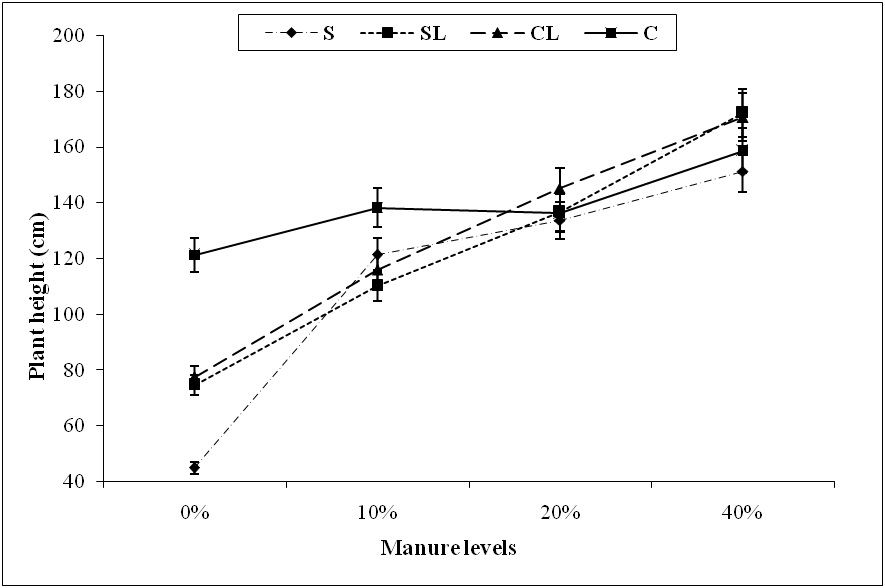 | Figure 4. Interaction effect of soil type and manure level on plant height of M. oleifera |
4. Discussion
- There was a positive dry biomass yield response to manure application in the current study. The yield response to manure can be attributed to the soil ameliorative effects of manure. This is consistent with Palm et al.[8] who reported that there is a potential to increase crop yields, while maintaining soil organic matter, through use of organic manure The high biomass recorded with application of manure is probably due to improved nutrient availability because the manure used had 1.66% N, 0.19% P and 1.73% K. Manure improves cation exchange capacity (CEC) and its application can also result in higher water holding capacity (WHC) especially in sandy soils[9]. An increase in soils organic matter of 0.5% was shown to increase water and nutrient holding capacity by about 10%. Murwira and Mugwira[10] concluded that application of manure promote sustainability of soil fertility through the recycling of nutrients and improvement of soil structure. Manure contains beneficial microbes that can promote more effective root growth, aid in moisture retention in the crop root zone hence the seedling roots develop rapidly. Organic carbon also increases with application of manure. Murwira[9] highlighted that application of manure increased organic carbon by 38% in the top 0-10cm layer with first year application. Murwira[9] also reported that application of manure increased soil water retention in sandy soils. Exchangeable K, Ca and Mg have also been reported to increase progressively with manure applications thus increasing plant available bases[11].Manure has been shown to have a positive effect on availability of nitrogen, phosphate and other nutrients in nutrient fixing soils[11,12]. Due to their content of electron-donor functional groups, humic substances can form complexes with Mn and Al3+, detoxifying soils from high concentrations of Al. Tisdale et al.[13] noted that organic matter reduces the effects of toxicity by Al and Fe, increasing root growth and availability of plant nutrients like P and N which are essential nutrients for plant growth, hence increasing yields that concurred with the current study where biomass yield increased with increase in amount of manure added.Shoot and root dry matter increased with an increase in amount of manure applied. Application of 40% manure resulted in 212.2%, 52% and 102% increase in root dry matter of M. oleifera compared to control in sandy, sandy loam and clay loam soils. The biomass response to manure application in sandy soils may be due to the fact that the inherent organic matter of the soil was low as compared to other soils. Artin and Rice[14] showed that on very poor and alkaline Haitian soil, fertilization with organic matter increased growth of M. oleifera. Yamoah[15] showed that an increase in rooting depth increased the ability to resist moisture stress, leading to increased growth and biomass of Leucaena tree seedlings in both acid and non-acid soils.This study also revealed different responses of M. oleifera in different soils. Root mass of 14, 18, 23 and 26.9 g were recorded in sandy, sandy loam, clay loam and clay soils. Low yields in sandy soils compared to clay soils can be attributed to low soil nutrients and low pH (4.2) which might have hindered nutrient availability. Aluminum toxicity increases exponentially at low pH (4.2) resulting in roots toxicity that reduce plant growth and yields[13]. Aluminum also affects root development, resulting in short stunted roots and this is more prevalent in soils with low pH. Chikowo[16] reported that deleterious effects of soil acidity on crops are mainly impairment of root development and growth which is later manifested as poor plant growth. Manure application (40%) in sandy soils recorded 212.2% increase in plant height. Increases in dry matter observed could be due to increased pH and improved nutrient availability status of the soil brought about by addition of manure.Although manure analysis results showed low N and P content, the increases in plant dry matter could be due to high amounts of bases recorded in the manure. Grant[11] observed that the benefit which accrues from fertilizing with manure was due to more amounts of bases released than to the supply of N. It was also noted that crop responses to manure on sandy soils are often due to the contribution of P and the cations such as calcium and magnesium, than the addition of N[11]. N is lost during composting process of manure[17]. The best response of manure in sandy soils can also be due to higher mineralization rate in sandy soils compared to other soils. Murwira and Mugwira[10] showed that rate of mineralization depends on the soil texture and rate of N mineralization was shown to be lower in clay soils than sandy soils because clay particles shield organic matter from decomposition. Higher mineralization means higher nutrients availability for plant growth. Annual N mineralization of Zimbabwean soils have been found to be about 5% for sandy soils and about 2-3% for clay soils[18].The interaction effect of manure level and soil type on the growth of M. oleifera implies that the plant does very well under higher rates of manure and high clay content. M. oleifera growth is negatively affected when manure level is reduced in sandy soils.
5. Conclusions
- There was a strong linear relationship between establishment and growth of M. oleifera and manure application rates. It was concluded that soil type and manure application rates had effects on M. oleifera establishment and growth in terms of number of branches, root and shoot dry matter as well as the total dry matter.
ACKNOWLEDGEMENTS
- The authors would like to acknowledge the management and staff of Africa University and the Midlands State University for provision of expertise and necessary materials / resources for the experiment to be successfully carried out.
 Abstract
Abstract Reference
Reference Full-Text PDF
Full-Text PDF Full-text HTML
Full-text HTML

